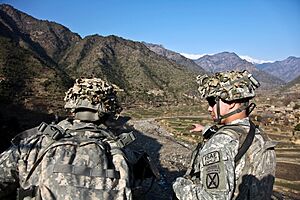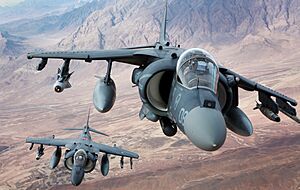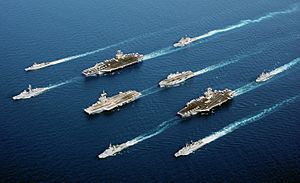Operation Enduring Freedom facts for kids
Quick facts for kids Operation Enduring Freedom |
|||||
|---|---|---|---|---|---|
| Part of the war on terror and War in Afghanistan | |||||
 U.S. soldiers of the Army's 10th Mountain Division deployed during Operation Enduring Freedom 2009 |
|||||
|
|||||
| Belligerents | |||||
|
In Afghanistan: (completed)
In the Philippines: (completed) In Somalia/Horn of Africa:
In Georgia: (completed) In Kyrgyzstan: (completed) Other nations |
In Sahara:
|
||||
| Commanders and leaders | |||||
|
|
|||||
| Casualties and losses | |||||
|
Others 200+ killed |
|
||||
Operation Enduring Freedom (OEF) was the name the U.S. government gave to its military actions after the September 11 attacks in 2001. It was a major part of the Global War on Terrorism. On October 7, 2001, President George W. Bush announced that airstrikes had begun in Afghanistan. These strikes targeted Al-Qaeda and the Taliban.
Operation Enduring Freedom also included efforts to fight terrorism in other countries. Examples are OEF-Philippines and OEF-Trans Sahara. After 13 years, on December 28, 2014, President Barack Obama announced the end of OEF in Afghanistan. Later operations by the U.S. military in Afghanistan were called Operation Freedom's Sentinel.
Contents
What Was Operation Enduring Freedom?
Operation Enduring Freedom (OEF) was the main U.S.-led military effort in Afghanistan. It also covered anti-terrorism actions in other countries. These operations aimed to fight groups like Al Qaeda and the Taliban.
Some of the main parts of OEF included:
- Operation Enduring Freedom (OEF) in Afghanistan: From October 7, 2001, to December 31, 2014. It was followed by Operation Freedom's Sentinel.
- Operation Enduring Freedom – Philippines (OEF-P): From January 15, 2002, to February 24, 2015.
- Operation Enduring Freedom – Horn of Africa (OEF-HOA).
- Operation Enduring Freedom – Trans Sahara (OEF-TS): Focused on fighting terrorism in the Sahara region.
Why Was It Called "Enduring Freedom"?
The U.S. government used "Operation Enduring Freedom" to describe its actions in Afghanistan. This name was used from October 7, 2001, to December 31, 2014. The next operations in Afghanistan were named Operation Freedom's Sentinel.
The operation was first called "Operation Infinite Justice." However, this name was changed. Phrases like "infinite justice" are often used by religious groups to describe God. The change aimed to avoid offending Muslims, who are the main religion in Afghanistan.
Also, in September 2001, President George W. Bush used the word "crusade" when talking about the war on terrorism. This caused criticism from the Islamic world. This might have also led to the name change.
OEF usually refers to the war in Afghanistan from 2001 to 2014. Other operations, like the Georgia Train and Equip Program, were also part of OEF. All these operations focused on fighting terrorism.
Operation Enduring Freedom was a joint effort by the U.S., U.K., and Afghan forces. It was separate from the International Security Assistance Force (ISAF). ISAF was a group of North Atlantic Treaty Organization (NATO) countries, including the U.S. and U.K. Both operations happened at the same time.
How Operation Enduring Freedom Started
Operation Enduring Freedom began on October 7, 2001. This was a response to the September 11 attacks. The first military actions involved strikes from land-based bombers and carrier-based fighter jets. Tomahawk cruise missiles were also launched from U.S. and British ships and submarines.
President George W. Bush set the goals for OEF. These included destroying terrorist training camps in Afghanistan. They also aimed to capture al-Qaeda leaders and stop terrorist activities there.
In January 2002, over 1,200 soldiers from the U.S. Special Operations Command Pacific (SOCPAC) went to the Philippines. They helped the Armed Forces of the Philippines (AFP) fight terrorist groups. These groups included Abu Sayyaf Group (ASG), al-Qaeda, and Jemaah Islamiyah. The operation involved training the AFP and providing humanitarian aid. This aid was part of Operation Smiles.
In October 2002, military forces set up Camp Lemonnier in Djibouti. The goals were to give humanitarian aid and patrol the Horn of Africa. This aimed to weaken terrorist groups in the region. Like OEF-P, humanitarian aid was important. It helped prevent militant groups from gaining support among the people.
The military part of the operation involved checking ships for illegal goods. It also included training and equipping local armed forces. The humanitarian part involved building schools, clinics, and water wells. This helped build trust with local communities.
Since 2001, the U.S. government spent over $150 billion on Operation Enduring Freedom.
Operation Enduring Freedom in Afghanistan
The Taliban's Rule
After the Soviets left Afghanistan, the Taliban took control from 1996 to 2001. They followed a very strict interpretation of Islamic law. They banned music, television, sports, and dancing. They also enforced harsh punishments. Women were not allowed to appear in public or hold many jobs outside the home. The Taliban also destroyed the Buddhas of Bamyan. These were ancient statues nearly 1,500 years old, which the Taliban saw as idols.
In 1996, Osama bin Laden, a Saudi, moved to Afghanistan. He formed an alliance between the Taliban and his al-Qaeda organization. Al-Qaeda-trained fighters, known as the 055 Brigade, worked with the Taliban army. The Taliban and bin Laden had very close ties.
U.S.-Led Coalition Actions
On September 20, 2001, the U.S. stated that Osama bin Laden was behind the 11 September attacks. The U.S. gave the Taliban five demands:
- Hand over all al-Qaeda leaders to the U.S.
- Release all foreign prisoners.
- Close every terrorist training camp immediately.
- Give all terrorists and their supporters to the right authorities.
- Allow the U.S. full access to terrorist training camps for inspection.
On September 21, 2001, the Taliban refused these demands. They said they had no proof linking bin Laden to the attacks. The United Arab Emirates and Saudi Arabia then stopped recognizing the Taliban as Afghanistan's government. This left Pakistan as the only country with diplomatic ties to the Taliban.
On October 4, 2001, the Taliban reportedly offered to hand bin Laden over to Pakistan. He would be tried in an international court following Islamic law. On October 7, 2001, the Taliban suggested trying bin Laden in Afghanistan in an Islamic court. The U.S. immediately rejected this.
On October 14, 2001, the Taliban offered to give bin Laden to a third country for trial. But they wanted proof of his involvement in the September 11 attacks first. On January 16, 2002, the UN Security Council froze assets and placed an arms ban on bin Laden, al-Qaeda, and the Taliban.
Starting Combat Operations
On October 7, 2001, American and British warplanes began attacking Taliban and al-Qaeda forces. Cruise missiles were also fired from warships.
The Northern Alliance, with help from U.S. Special Operations teams, fought the Taliban. With U.S. bombing and many Taliban fighters leaving, the Northern Alliance quickly took Mazar-i-Sharif on November 9. They soon controlled most of northern Afghanistan. They took Kabul on November 13 after the Taliban suddenly left the city. The Taliban were pushed into a smaller area. Kunduz, their last city in the north, was captured on November 26. Most Taliban members fled to Pakistan.
The fighting continued in southern Afghanistan, where the Taliban retreated to Kandahar. In Kandahar, the Taliban offered to surrender. However, U.S. Secretary of Defense Donald Rumsfeld rejected the deal. It would have given Mullah Mohammed Omar, the Taliban leader, a pardon. After Kandahar fell in December, some Taliban and al-Qaeda members continued to fight. In November 2001, the U.S. military set up its first ground base in Afghanistan, called FOB Rhino, near Kandahar.
The Battle of Tora Bora happened in December 2001. U.S., British, and Northern Alliance forces worked to destroy the Taliban and suspected al-Qaeda members. In early March 2002, the U.S. military and Afghan forces launched a large operation called Operation Anaconda to destroy al-Qaeda.
This operation involved U.S. forces like the 10th Mountain Division and 101st Airborne Division. Other countries also helped, including British Royal Marines, Norwegian, Canadian, German, Australian, and New Zealand special forces. The Afghan National Army also took part.
After avoiding U.S. forces in mid-2002, the Taliban slowly regained strength. In May 2006, a U.S. and Canadian-led operation, Operation Mountain Thrust, was launched to fight the renewed Taliban attacks.
Since January 2006, the NATO International Security Assistance Force (ISAF) took over combat duties in southern Afghanistan. This NATO force included troops from Britain, Canada, and the Netherlands, among others. The U.S. military also continued its own operations in other parts of Afghanistan as part of Operation Enduring Freedom.
International Support
Many countries supported the United States during Operation Enduring Freedom in Afghanistan. These countries helped in various ways, directly or indirectly.
Results of OEF in Afghanistan

The U.S.-led group of countries first removed the Taliban from power. They also greatly weakened al-Qaeda and other militant groups in Afghanistan. However, stopping the Taliban's return after the 2001 invasion became difficult. As the war continued, the Taliban showed they could not be fully defeated. This was partly because they found safe places in neighboring Pakistan.
On October 9, 2004, Afghanistan held its first direct elections. Hamid Karzai was elected president. The next year, Afghans held parliamentary elections on September 18, 2005. Since the invasion, many schools and mosques were built. Millions of dollars in aid were given out. The amount of violence also went down.
While military forces fought against rebels and provided some safety, special teams helped build roads and bridges. They also assisted during floods and provided food and water to refugees. Many local leaders agreed to support the Afghan government. They formally gave up their soldiers and weapons. However, later actions sometimes made people question their true loyalty.
The Afghan National Army, Afghan National Police, and Afghan Border Police were trained to protect their country.
Operation Enduring Freedom officially ended on December 31, 2014. It was replaced by Operation Freedom's Sentinel on January 1, 2015.
In 2020, the U.S. agreed to leave Afghanistan. This agreement allowed American forces to leave safely by mid-2021. On August 15, 2021, the Taliban took control of almost all of Afghanistan, except Kabul. By August 31, all U.S. and allied forces left the airport in Kabul. This marked the end of official operations in Afghanistan.
Operation Enduring Freedom – Philippines (OEF-P)
About Abu Sayyaf Group
The Abu Sayyaf Group (ASG) is considered a "foreign terrorist organization" by the United States. It is an Islamist group based in the southern islands of the Philippines. These islands include Jolo, Basilan, and Mindanao.
Since the early 1990s, the group has carried out bombings, killings, kidnappings, and extortion. They do this to fight for an independent Islamic state. Their bigger goal is to create a large Islamic state across parts of Southeast Asia.
About Jemaah Islamiyah
Jemaah Islamiyah (JI) is a militant Islamic group. It aims to create a strict Islamic government in Southeast Asia. This includes Indonesia, Singapore, Brunei, Malaysia, southern Thailand, and the Philippines. JI first tried to achieve its goals peacefully. But later, because of its links with al-Qaeda, it started using terrorism.
JI has financial connections with other terrorist groups, like Abu Sayyaf and al-Qaeda. Jemaah Islamiyah means "Islamic Group" or "Islamic Community."
Jemaah Islamiyah is believed to have killed many civilians. It is also suspected of carrying out several bombings. These include the Zamboanga bombings, the Metro Manila bombings, the 2004 Australian embassy bombing, and the 2005 Bali terrorist bombing.
U.S. Actions in the Philippines
In January 2002, 1,200 members of the U.S. Special Operations Command, Pacific (SOCPAC) went to the Philippines. They helped the Armed Forces of the Philippines (AFP) fight al-Qaeda, Jemaah Islamiyah, and Abu Sayyaf. SOCPAC members helped with military operations and humanitarian aid. This aid was for the island of Basilan, where much of the fighting was expected.
U.S. Special Forces trained and equipped the AFP's special forces. They created the Light Reaction Company (LRC). The LRC and SOCPAC members went to Basilan after their training. Their goals were to stop ASG from having safe places. They also wanted to watch and control ASG routes. They supported the AFP's "strike force" and helped with community projects.
Results in the Philippines
The main goal was for the AFP to become strong enough to find and destroy the ASG. They also aimed to rescue hostages and make the Philippine government more trusted. Much of the operation was successful. The ASG was driven out of Basilan, and one U.S. hostage was rescued. The Abu Sayyaf Group's numbers dropped from over 800 members to less than 100.
The humanitarian part of the operation, called Operation Smiles, built 14 schools, 7 clinics, and 3 hospitals. It also provided medical care to over 18,000 people in Basilan. Humanitarian groups could continue their work without fear of kidnappings or attacks from the Abu Sayyaf Group.
Operation Enduring Freedom – Horn of Africa (OEF-HOA)
Unlike other OEF operations, OEF-HOA did not target one specific terrorist group. Instead, it focused on finding and stopping terrorist activities in the region. It also worked with local countries to prevent terrorist groups from returning. Operations began in mid-2002 at Camp Lemonnier.
In October 2002, the Combined Joint Task Force, Horn of Africa (CJTF-HOA) was set up in Djibouti at Camp Lemonnier. CJTF-HOA had about 2,000 people, including U.S. military and Special Operations Forces. It also included forces from other countries, forming Combined Task Force 150 (CTF-150). This group included ships from Australia, Canada, France, Germany, and many other nations. Their main goal was to check ships entering the Horn of Africa region for illegal goods. Since 2003, the U.S. military also targeted al-Qaeda-linked fighters in Somalia.
CJTF-HOA spent most of its efforts training military units in Djibouti, Kenya, and Ethiopia. They taught them how to fight terrorism and rebel groups. CJTF-HOA also helped with humanitarian efforts. These included rebuilding schools and medical clinics. They also provided medical services to the countries whose forces were being trained. This program expanded to include training forces in Chad, Niger, Mauritania, and Mali.
U.S. Actions in the Horn of Africa
"Operation Enduring Freedom"
- October 7, 2001 – December 28, 2014
- U.S. and Allied Deaths: 3,486
- Taliban/Al-Qaeda Deaths: 25,500–40,500
The coalition also carried out anti-piracy operations in 2006. In March, U.S. ships were attacked by pirates. In January 2007, during the war in Somalia, a U.S. airstrike targeted al-Qaeda members. These members were with forces of the Islamic Courts Union (ICU) in southern Somalia. U.S. naval forces, including the aircraft carrier USS Dwight D. Eisenhower, were near Somalia's coast. They provided support and stopped al-Qaeda forces from escaping by sea. Actions against pirates also happened in June and October 2007.
"Operation Resolute Support/Freedom's Sentinel"
- January 1, 2015 – Present
- U.S. and Allied Deaths: 70+ (as of early 2015)
On January 1, 2015, Secretary of Defense Hagel announced a new U.S. mission in Afghanistan. It was called Operation Freedom's Sentinel. This mission focused on training, advising, and helping Afghan security forces. About 13,500 U.S. troops were expected in Afghanistan through 2015. They were helped by troops from NATO allies.
Military Awards
Since 2002, the United States military has created special awards for those who served in Operation Enduring Freedom:
- Afghanistan Campaign Medal
NATO also created a military award for Operation Enduring Freedom:
- Non-Article 5 ISAF NATO Medal
See also
- Operation Herrick
- Coalition casualties in Afghanistan
Images for kids



